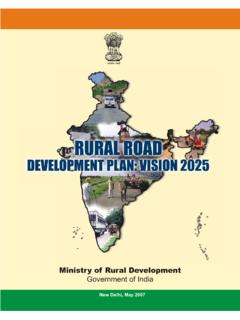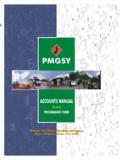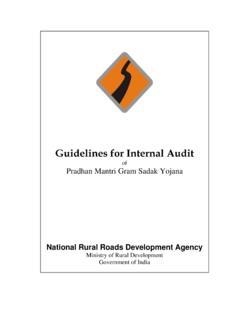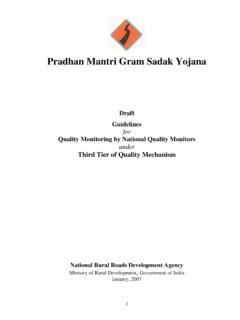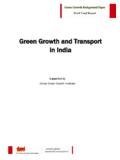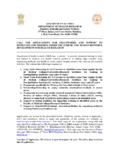Transcription of SOCIO-ECONOMIC IMPACT ASSESSMENT REPORT …
1 SOCIO-ECONOMIC IMPACT ASSESSMENT REPORT . RURAL ROADS PROJECT - 1. CHHATTISGARH. (ADB LOAN NO. 2018-IND). APRIL 2009. TECHNICAL SUPPORT CONSULTANTS. OPERATIONS RESEARCH GROUP PVT. LTD. Contents INTRODUCTION .. 1. STUDY COVERAGE .. 1. STUDY APPROACH .. 2. SOCIO-ECONOMIC IMPACT ASSESSMENT .. 4 Transportation Related IMPACT .. 4 Traffic Volumes .. 4 IMPACT on Transport Users .. 5 Villagers' Perceptions (Focus Group) About IMPACT .. 6 Village Primary Data (Key Informant & Self-Monitoring) on IMPACT Monitoring & ASSESSMENT 8 Change Process Impacting Households (Household Tracer Survey).. 11 SOCIO-ECONOMIC IMPACT ASSESSMENT REPORT - Chhattisgarh MONITORING OF SOCIO-ECONOMIC IMPACT CHHATTISGARH RURAL ROADS. INTRODUCTION.
2 The project relates to a multi-year program to document and analyze the SOCIO-ECONOMIC impacts of the construction/. improvement of about 5500 Km of village and Other District Roads (ODR) in Chhattisgarh state through ADB funding of Rural Roads Project No. 1. It is expected that once the project is completed, it will impart direct and indirect benefits to the road users as well as to the people living in the areas/ villages abutting the project roads. The Project Management Consultants appointed by NRRDA completed the baseline surveys and the subsequent semi-annual surveys during the years 2006 to 2008. The Technical Support Consultants completed the residual surveys in December 2008. The baseline survey REPORT was submitted in the year 2006.
3 In continuation to that REPORT , this REPORT presents the ASSESSMENT of the SOCIO-ECONOMIC IMPACT using the data collected as a result of the surveys conducted in December 2008 as mentioned above. As per the requirement of the TOR, the Consultant has carried out the following surveys: 1) Traffic Survey (on Sample project and control roads). 2) Road Users/ Passengers Survey (on Sample project and control roads). 3) Sample Villagers' Perception (Focus Group). 4) Village Primary Data Collection (Key Informant Interviews). 5) Village Primary Data Collection (Community Self Monitoring). 6) Household Tracer study (Change Process). The surveys have adopted a systematic and well defined approach based on preparation of pre- improvement (ex- ante) baseline data for Project Road and Control Roads , updating the data systematically in pre-defined intervals over a period of about three years.
4 It also includes gathering data/ information through regular community consultation and community based monitoring to verify the change process due to the road improvement. STUDY COVERAGE. The present study considers the roads included in the first batch of the ADB funding, having a length of about 500. Km and serving about Lakh of population. It covers 70 roads spread out in 211 habitations in different parts of the state. The Batch I roads are the universe for drawing the samples according to the framework set out in Table Operations Research Group 1. Technical Support Consultants SOCIO-ECONOMIC IMPACT ASSESSMENT REPORT - Chhattisgarh Table : Framework and Sample- Size for SOCIO-ECONOMIC IMPACT Monitoring & ASSESSMENT Survey Sl.
5 No. Subject Instrument/ Source Frequency Scope 1. Traffic Survey 24 hour traffic counts Annual 35 project roads, 10 roads control 2. Road Users/ Passengers 20 project roads, 6 roads control Passengers/Users Annual Survey 3. Principal village for each 20 project Villagers Perceptions Village focus group Annual roads, 6 control roads 4. Key informants Principal village for each 20 project Village Primary Data Annual interview roads, 6 control roads 5. Community self- Principal village for each 5 project Village Primary Data Quarterly*. monitoring roads 6. Household tracer 10 households in principal villages Change Process Quarterly*. studies for each of 5 project roads * On the basis of the experience gained during the baseline survey and a subsequent quarterly survey in 2006, it was found that for the sake of the convenience of the respondents and the nature of data being collected, the two quarterly surveys can be changed to bi-annual surveys; the same has been communicated to NRRDA.
6 The definition of the key words used in the above table is as follows. Project Road (PR): The rural roads that have been improved / constructed under the Batch 1 of ADB funding. Control Roads (CR): The roads that are not included in Batch 1 or any other program for road improvement/. construction and also not likely to be taken-up for improvement/ construction during the study period (2005-06 to 2007-08). These roads are located in similar SOCIO-ECONOMIC milieu as the project roads. Principal Village (PV): For a project/ control road or a set of project/ control roads, the village falling in its/ their influence area ( being served by project/ control road), and having the maximum population (surrogate for the level of development) from among all the villages in the influence area.
7 Households (HH): A house hold (single family) selected for the purpose of survey (household tracer survey) located in the villages falling in the influence area of a project road STUDY APPROACH. The suggested approach given in the Terms of Reference (ToR) of the study involves a multi-year surveys on the ASSESSMENT of the IMPACT of the rural road project, over a period of three years (2005-06 to 2007-08). This is to be achieved by adopting a before-after-with-and-without' approach for each of the monitoring instrument and by (i). establishing a control sample of roads selected to match the types of road conditions and social conditions of the Operations Research Group 2. Technical Support Consultants SOCIO-ECONOMIC IMPACT ASSESSMENT REPORT - Chhattisgarh roads to be improved, and (ii) before implementation of the project improvements, conducting a baseline survey for selected first batch of ADB financed road projects and control roads, and iii) after improvement conducting annual monitoring surveys for the same first batch of project roads and control roads.
8 While adopting the above approach it may be pertinent to remove the effect of the other factors / schemes (other than the IMPACT of road project) that would benefit the population living in the project rural road area. This is done through establishing the counterfactual ( , what would have happened had the project never taken up or what other-wise would have been true in the absence of the project). The concept of counterfactual is introduced in the IMPACT analysis exercise through the use of comparison' or control' groups. The selection of control roads is crucial to the IMPACT evaluation design and the method is based on the nature of a project being analyzed. The present project resembles a case of ex-post selection process where the benefited' and control' groups were not formed through experimental design, rather they are selected after the projects were identified or were being implemented.
9 Thus the non-random method is more suitable for the present analysis where the control' group resembles the benefit' group on the basis of some observed characteristics. In the present analysis, population served' by a road is considered as the characteristics for resemblance between the control'. roads and project' roads. The IMPACT evaluation is based on the double-difference (difference in-difference) method, in which the first difference between the control' and benefit' groups is taken before the project and the second difference is taken after the project implementation. The schematic diagram showing the application of double- difference method is presented as Diagram Diagram : Application of Double Difference Method Base Line Survey Multi-Year Survey Percentage Change Percentage Change (First Difference) (Second Difference).
10 Project Roads (PB). Project Roads (PA) X : PA - PB. X-Y. Control Roads Y : CA - CB. Control Roads (CA). (CB). In addition to the quantitative data collection and its analysis, qualitative data has been collected and analyzed, mainly with a view to perform consistency checks identifying any other variable that are important for IMPACT ASSESSMENT and obtaining feedback from the people that would help in data interpretation and analysis. Operations Research Group 3. Technical Support Consultants SOCIO-ECONOMIC IMPACT ASSESSMENT REPORT - Chhattisgarh SOCIO-ECONOMIC IMPACT ASSESSMENT . Following the study approach described above, the SOCIO-ECONOMIC impacts resulting from the improvement/. construction of the project roads, have been assessed through the use of the six Survey Instruments presented in Table First two survey instruments are used to assess transport related impacts; the 3rd, 4th, and 5th instruments concern village level information/ data; and the 6th instrument monitors the change process at the sample house hold' levels.
